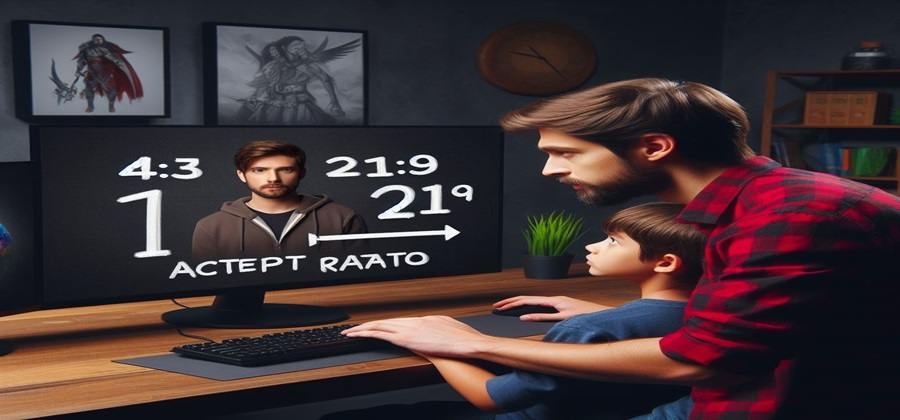
The choice between 4:3 and 21:9 aspect ratios depends on your specific needs. 4:3 is better for standard viewing and classic content, while 21:9 offers a wider field and is ideal for cinematic experiences and gaming.
Choosing the right aspect ratio for your display can significantly enhance your viewing experience. The 4:3 ratio, once standard, suits traditional television broadcasts and classic films perfectly, providing a comfortable viewing experience without unnecessary stretching or cropping.
On the other hand, the 21:9 aspect ratio, also known as ultrawide, is tailored for modern cinema and expansive gaming landscapes.
It allows viewers to see more horizontal content, making it a favorite among movie enthusiasts and gamers seeking immersion in their visual experiences. Each ratio serves different purposes, so understanding your primary use is key to making the best choice.
- Introduction To Aspect Ratios
- Diving Into 4:3 Aspect Ratio
- Exploring 21:9 Aspect Ratio
- Comparative Analysis: 4:3 Vs 21:9
- User Perspectives And Preferences
- Industry Adoption Trends
- Technical Considerations
- Future Of Aspect Ratios
- Frequently Asked Questions
- Is 21:9 A Good Aspect Ratio?
- Is 4:3 Or 16:9 Better?
- What Are Some Benefits Of 16:9 Aspect Ratio Displays Compared To 4:3 Aspect Ratio Displays?
- What Are The Benefits Of 21:9?
- Conclusion
Introduction To Aspect Ratios
Aspect ratios play a pivotal role in visual experiences. They determine how content is displayed on screens. The term aspect ratio refers to the width of the image relative to its height. It’s represented by two numbers separated by a colon.
Screen dimensions significantly affect user engagement and viewing satisfaction. The right aspect ratio can provide an immersive experience. It can also ensure that no content is lost or distorted during playback.
Screen aspect ratios have seen a substantial shift over time. The once-popular 4:3 ratio dominated early television and computer monitors. Contemporary displays often feature wider formats, like the 21:9 ratio. This evolution reflects the changing consumption patterns and technological advancements.

Diving Into 4:3 Aspect Ratio
The 4:3 aspect ratio holds deep roots in the history of visual displays. Originating from traditional television and computer monitors, this format became a standard. Its square-like shape was ideal for a variety of content including early video games and standard-definition television.
Today, 4:3 is celebrated for its vintage appeal, often used by filmmakers to invoke nostalgia or to stand out. Educational programs and classic films also employ this ratio, offering a familiar viewing experience. Despite its age, the aspect ratio finds relevance in tablets and mobile devices, catering to specific user needs.
The primary advantages of 4:3 include its compatibility with older content and its efficient use of vertical space, beneficial for reading and browsing. On the downside, it presents black bars on widescreen content and lacks the immersive qualities of wider formats. Users may feel the ratio is outdated when consuming modern media.
Exploring 21:9 Aspect Ratio
The 21:9 aspect ratio, often seen in ultra-wide monitors, offers a vastly immersive experience for users. Its wide field of view is ideal for cinematic content and productivity tasks like video editing and spreadsheets. By spanning wider than traditional screens, it allows for multiple open windows without the need for a second monitor.
Yet, this format has its drawbacks. Certain games and videos may not support the ultra-wide setup, leading to black bars on the sides of the content.
Some users might find the extra screen real estate overwhelming or unnecessary for their needs. The cost is also a consideration, as 21:9 monitors can be more expensive than their 16:9 counterparts.
Comparative Analysis: 4:3 Vs 21:9
Comparing 4:3 and 21:9 aspect ratios reveals distinct differences. The 4:3 aspect ratio, traditional and square-like, suits older content and standard-definition TV. It often results in black bars on modern displays.
On the other hand, 21:9, also known as ultra-wide, offers a broad, cinematic view. Ideal for movies and gaming, it provides an immersive visual experience.
The availability of content in 21:9 is growing, especially in films and games. Yet, 4:3 content is less common today. Users may find more modern content formatted for wider screens. This makes 21:9 a better choice for current media consumption.
Device compatibility varies between the two ratios. The 4:3 ratio works well with older monitors and tablets. Conversely, 21:9 displays require compatible hardware. Not all devices support ultra-wide resolutions, which can limit usage.
User Perspectives And Preferences
Recent surveys show that user preferences vary widely between 4:3 and 21:9 aspect ratios. A significant number of users favor 21:9 for its immersive experience in gaming and movies. Conversely, 4:3 is preferred for productivity tasks like document editing and web browsing.
Many personal stories reflect these findings. One user mentioned, “21:9 is perfect for my home cinema setup”. Another stated, “4:3 helps me manage spreadsheets better”. These anecdotes highlight how choices depend on individual use cases.

Industry Adoption Trends
Film and television mostly use the 21:9 aspect ratio. This wide format makes movies look really cool and cinematic. It’s great for big, sweeping scenes.
Gaming and computing have started to adopt 21:9 more often too. This wider view helps gamers see more of their game world. It also lets computer users keep more windows open at once.
Technical Considerations
Understanding the resolution implications between 4:3 and 21:9 aspect ratios is crucial. Graphic designers often prefer 21:9 for its wider canvas. This ratio offers extra screen real estate, aiding in multitasking and providing a more immersive experience.
Conversely, the 4:3 aspect ratio appears more box-like, which can be beneficial for certain design tasks and software applications that are optimized for this dimension.
With the 21:9 layout, users might encounter black bars when viewing content not tailored for this ultra-wide format. It’s important to note that software compatibility varies with aspect ratios.
Some programs may not fully support the ultra-wide setup, leading to stretching or cropping issues. Therefore, selecting the ideal aspect ratio depends on the user’s specific needs and workflow.
Future Of Aspect Ratios
The aspect ratio battlefield is evolving rapidly. 4:3 was once the standard, but 21:9 is gaining traction, heralding a new era of immersive experiences. This wider format excels in providing panoramic views, making it a favorite for gamers and movie enthusiasts.
Industry leaders are investing in ultra-wide displays, suggesting a shift in user preference. The traditional 4:3 aspect ratio is seeing less use, with the market veering towards more expansive visuals.
Experts suggest that the future might bring even wider formats. These would cater to virtual reality and augmented reality applications. Flexibility and adaptability in screen aspect ratios will likely be key.
Emerging technologies such as foldable and rollable screens could redefine standards. They might introduce variable aspect ratios that adjust to specific content or user needs.
Predictions lean towards a diverse ecosystem of aspect ratios. This diversity will cater to various niches, rather than a one-size-fits-all solution.
Frequently Asked Questions
Is 21:9 A Good Aspect Ratio?
The 21:9 aspect ratio is ideal for cinematic content and expansive gaming views, offering a wider field of vision than standard screens.
Is 4:3 Or 16:9 Better?
The choice between 4:3 and 16:9 depends on your content needs. For classic shows or standard definition, 4:3 is ideal. Modern displays and high-definition content are best suited to 16:9. Choose based on your viewing preference and media format.
What Are Some Benefits Of 16:9 Aspect Ratio Displays Compared To 4:3 Aspect Ratio Displays?
16:9 displays offer wider viewing angles and better match high-definition content standards, enhancing visual experiences for gaming and movies. They also allow for more immersive multitasking with split-screen capabilities.
What Are The Benefits Of 21:9?
The 21:9 aspect ratio offers a wider field of view for immersive gaming and cinematic experiences, enhancing multitasking with split-screen capabilities.
Conclusion
Deciding between 4:3 and 21:9 aspect ratios hinges on your specific needs. Gamers and movie enthusiasts may lean towards the immersive 21:9. For productivity tasks, 4:3 could be the better fit. Your choice should align with your primary screen use, ensuring a satisfying visual experience.
Choose wisely for optimal viewing pleasure.

Brendon Martinez is a hardcore gamer with a background in electrical engineering and a passion for gaming, Brendon Martinez brings a unique blend of technical expertise and gaming enthusiasm to his writing. Having worked with leading tech companies, he dives deep into the intricacies of gaming technology and monitors, providing readers with detailed insights and reviews.